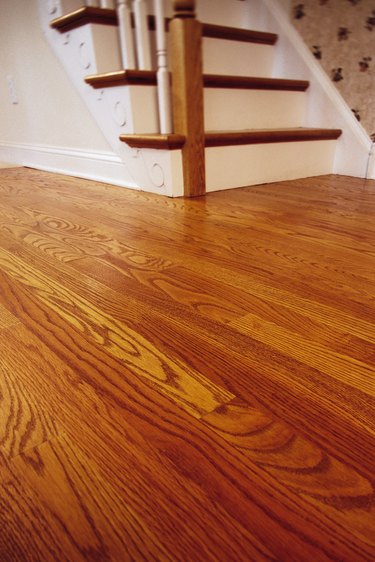
Not sanding a freshly laid hardwood floor and finishing it as is, makes the installation less messy and time-consuming, but it would be a mistake. Sanding levels the edges of the floorboards, which can vary from one another by as much as 1/4 inch. It also primes the wood surface for the stain and finish, and it's a necessary operation when you fill gaps between the boards, which you almost always have to do.Need tools for your project? Check out RentalHQ and get connected with local businesses that'll help you rent the equipment and tools you need.
Tip
Sponsored tip: Need tools for your project? Check out RentalHQ and get connected with local businesses that’ll help you rent the equipment and tools you need.
Video of the Day
Unfinished Flooring
All the boards in a given batch of unfinished, or raw, flooring are milled to the same thickness, but there are usually slight variations from board to board. These variations usually aren't apparent until you lay the floor and notice that the edges don't exactly match. Moreover, the boards have sometimes been left exposed to sunlight and moisture for enough time for the surfaces to become weathered and discolored. Additionally, if they're not dirty, chipped or gouged, they may have a film on them that can interfere with stain and finish penetration. Sanding is the only way to correct these problems.
Video of the Day
Filling Gaps and Voids
Unless raw flooring is kiln-dried or of the highest quality, some boards are likely to be warped, and some edges less than perfectly straight. Gaps between boards and small voids on the edges, however small, are an inevitable result after installation, and unless you're looking for a country-style floor to fit with a rustic design motif, you'll probably want to fill the gaps and voids with an appropriate filler. The easiest and most effective way to fill a new floor is to spread the filler over the entire area, then sand it off.
Sanding Technique for New Floors
Because of the likelihood for new unfinished flooring boards to be uneven, installers sometimes resort to a drastic sanding technique. They make the first pass with the floor sander diagonally across the boards, instead of going parallel to them. This is drastic because it makes deep scratch marks across the grain, but it levels the edges and flattens the floor more quickly, and avoids excessively wearing down the edges of cupped boards in order to sand their centers. Make subsequent passes in the same direction as the grain with the same grit sandpaper, then change to progressively finer grits of sandpaper, which usually removes the scratches.
Considerations
Raw wood flooring, more so than engineered varieties or pre-finished flooring, stabilized with a finish coat on both sides, is susceptible to moisture. It expands and contracts with changing climatic conditions in the room, and gaps may develop between the boards even after you have filled them and sanded the floor. Knowing this, you may opt to leave a new floor in a high-moisture location where the wood is more likely to move, like a porch or patio, not sanded and unfilled. The floor will eventually develop a weathered character that may suit its location.